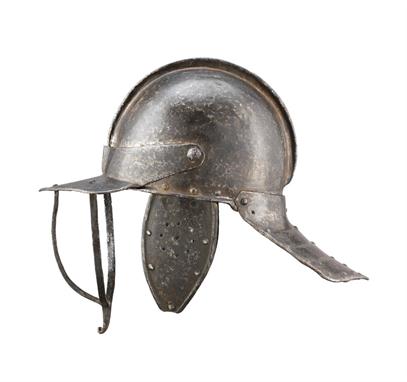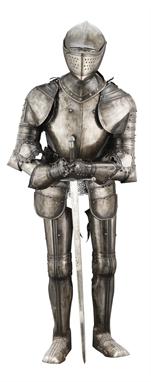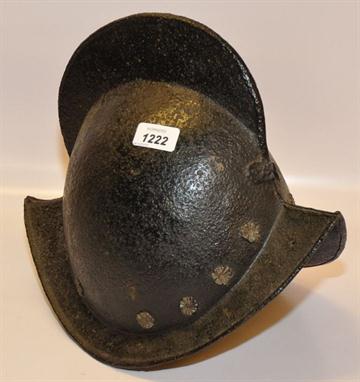We found 70386 price guide item(s) matching your search
There are 70386 lots that match your search criteria. Subscribe now to get instant access to the full price guide service.
Click here to subscribe- List
- Grid
-
70386 item(s)/page
A FINE SWEDISH ROYAL SWORD OF HONOUR GIVEN BY KARL XIV JOHAN, KING OF SWEDEN, WITH AMETHYST SET GILT-BRASS HILT AND GREEN PORPHYRY GRIP, CIRCA 1818-44 with curved pipe-backed blade double-edged towards the hilt, etched over its full surface and enriched with gilt and blued details, including elaborate trophies-of-arms, an eagle perched upon thunderbolts, the crowned Royal cypher `C XIV J`, an armoured figure, fasces entwined with foliage and a mounted carousel figure on one side and an owl as an allegory of wisdom upon a pair of fronds, the crowned Royal arms, fasces, a demi-armoured figure above a trophy involving pistols, and a figure in blued three-quarter armour on the other, the tip etched with a pattern of stars on a faux watered ground on each side, the back-edge engraved and gilt with conventional foliage over its length, gilt-brass hilt cast and chased in low relief, comprising a pair of langets decorated with a classical trophy-of-arms enclosed within a framework of flowers, foliate quillon with eagle`s head terminal, knuckle-guard decorated with neo-classical scrolls and trophies enclosing three hardstones, probably amethysts, and rising to the pommel, the latter formed as a plumed classical helmet set with the mask of Medusa at the front, green porphyry grip applied in gilt-brass with the crowned Royal cypher at the front, in its original leather-covered wooden scabbard with gilt-brass locket, middle band and chape each decorated with neoclassical foliage, scrolls and ornament including, on the chape an eagle upon thunderbolts, the middle band with a trophy involving a wyvern defending fasces, and an elaborate trophy of the locket, and remaining in very good to fine condition throughout 84cm; 33 1/4in blade Provenance Mauritz Axel, Greve Lewenhaupt (1791-1868), Marshal of The Realm (1849-60) and Over Governor of Stockholm (1841, 1842-44). The decoration is probably by Carl Gustaf Liljedahl of Stockholm. Another Royal sword of Honour with amethyst set hilt and green porphyry grips is preserved in the Royal Armoury, Stockholm, see L. Nordstrom 1984, cat. no. 26, pp. 107-8.
AN OFFICER`S HELMET, 1ST SUFFOLK YEOMANRY CAVALRY, CIRCA 1820-28 the skull of blackened jacked leather, in two parts sewn longitudinally, and fitted with a silver-plated metal crest of `Roman` style pierced at top-front for a plume and embossed with a Gorgon`s head at the front; the turban and rear pad of (faded) dark velvet with white metal chains, white metal peak-edging, side-strips and label embossed with the title 1ST REGT. SUFFOLK YEON. CAVALRY; white metal quatrefoil chin-scale bosses and overlapping chin-scales backed onto buff velvet and with silk ties at ends; rear tassel of fine twisted gold wire; with white metal plate at centre front, die-struck in the form of an eight-pointed star upon which is superimposed the Royal cypher GR within the Garter; the peak lined with black Russia leather; sweatband of glazed white cotton, 5 inches deep 28cm; 11in high; 28cm; 11in front-to-back This appears, like all other recorded helmets of this regiment and this type, to be a contemporary modification of the `Tarleton` helmets worn by the regiment from its formation in 1793/94 - the original bearskin crests of the earlier helmets having been removed and substituted by the `Roman` crests manifest in this and other examples circa 1820 in order to bring the regiment`s helmets up-to-date. Helmets of this form were presumably worn until the disbandment of the regiment in 1828. Carman, W.Y., Headdresses of the British Army: Yeomanry, Sutton, Surrey, 1970, p. 70; Journal of the Society for Army Historical Research, Vol. LXII (1984), p. 58 and plate B.
AN OFFICER`S HELMET AND CREST, NORFOLK YEOMANRY CAVALRY (PRINCE ALBERT`S OWN CORPS), CIRCA 1843-49 the helmet skull of black japanned metal, made in two parts and joined longitudinally, the crest of blackened lightweight material, possibly horn, the helmet embellished with gilded metal, with a gilded metal die-struck badge incorporating the Royal Arms above the title PRINCE ALBERT`S OWN CORPS, and with a crest of black horsehair; chin-scale bosses in the form of lions` masks and chin-scales of interlocking rings, backed onto black velvet; the front and rear peaks lined in green leather; the sweatband of quilted buff silk with a faded crimson silk interior; some minor damage to the skull 33.7cm; 13¼in high; 28cm; 11in front-to-back Provenance Mr Gerald Shapiro The Norfolk Yeomanry adopted helmets of this pattern in 1843, upon the regiment being honoured with the appellation `Prince Albert`s Own`, but was disbanded in 1849: Carman, W.Y., Headdresses of the British Army: Yeomanry, Sutton, Surrey, 1970, p. 58
A RARE SOUTH GERMAN INFANTRY HALF-ARMOUR, MID-16TH CENTURY, PROBABLY NUREMBERG, INCORPORATED INTO A LATER FULL ARMOUR comprising `almain` collar of three lames front and rear with integral spaudlers of six lames each, all embossed around the borders with a pattern of repeated scallops (some disarticulations), breastplate formed of a main plate with recessed ogee border beneath the neck and strong medial ridge projecting forward over the belly (so-called Tapulbrust), fitted with a pair of moveable gussets at the arm openings and flanged outwards at its base to receive a skirt of two-lames, contemporary three-piece backplate of similar type, a pair of pendent tassets each of seven lames, and decorated throughout with file-roped turns at the principal edges, together with later close helmet with two-piece skull joined along a roped medial comb, and `sparrow`s beak` visor, a pair of full leg-defences in gothic style including long pointed sabatons fitted with spurs, and a pair of etched fingered gauntlets: on a padded dummy with wooden stand A number of infantry armours of this quality are associated with the former city arsenal in Vienna.
AN ENGLISH HARQUEBUSIER`S POT HELMET, MID-17TH CENTURY with two-piece skull joined along a low turned comb (one internally patched repair), fitted at its nape with a pointed neck-guard of four simulated lames and at its brow with a pivoted peak supporting a three-bar face-defence, and with a pair of pendent ear-defences, each pierced with a circular arrangement of holes 33.5cm; 13 1/4in high
A FULL ARMOUR IN 16TH CENTURY STYLE, LATE 19TH/20TH CENTURY comprising visored close helmet fitted with pivoting visor, gorget formed of two plates front and rear, breast-plate flanged outwards at the base to receive a skirt of one lame and a pair of tassets each of four lames, backplate, a pair of full leg defences with articulated sabatons, a pair of full arm defences with fingered gauntlets, on a wooden stand, together with a matching sword
A MINIATURE FULL ARMOUR IN 16TH CENTURY STYLE, LATE 19TH/20TH CENTURY of steel, comprising close helmet with hinged visor and bevor, the latter pierced with a horizontal arrangement of breathes, and low riveted brass comb, cuirass including breast-plate fitted with a central brass panel in imitation of a plackart, a pair of tassets, a pair of full leg-defences including sabatons with pointed brass toes, a pair of full arm defences with fingered gauntlets, on a turned wooden base and complete with a sword and shield 49.5cm; 19 1/2in including base
A NORTH GERMAN CLOSE HELMET, CIRCA 1560-80, PROBABLY BRUNSWICK with rounded one-piece skull rising to a roped medial comb and fitted at the nape with a plume-holder (the skull with an early patched repair and one small hole), visor, upper bevor and bevor attached by common pivots (replaced), each secured at the right side by a spring-catch (that for the visor missing its lifting-peg), the visor with stepped centrally-divided vision-slit and pierced with six rectangular and four circular ventilation holes and a pair of holes for the attachment of a brow reinforce, the prow-shaped upper bevor pierced with circular arrangements of ventilation holes, two gorget-plates front and rear (rusted throughout) and later leathers 40.6cm; 16in high
A PAIR OF NORTH GERMAN `BLACK AND WHITE` TASSETS OF ADJUSTABLE LENGTH AND FURTHER DETACHED ELEMENTS OF BLACK AND WHITE ARMOUR, BRUNSWICK, CIRCA 1560-70 the tassets disarticulated, each formed of eight lames divisible between the fourth and fifth and eighth and ninth lames, detachable poleyns of four lames with a small centrally-puckered circular side-wing, decorated throughout with roped turns and with bright recessed bands on a black ground (areas of light rust, the leathers and rivets all missing); together with two gorget-plates from a close helmet, an upper and lower cannon from a black and white armour, and six further lames of pauldrons (24)
A CUIRASSIER CLOSE HELMET, PROBABLY NORTH GERMAN, CIRCA 1620 with rounded skull formed in two pieces and joined along the crest of a high medial comb, visor, bevor and lower bevor attached by common pivots, the visor with broad centrally divided vision-slot and fitted at the right with a lifting-peg, the bevor pierced on each side with a circular lozenge-shaped arrangement of ventilation holes and secured by a hook-and-eye catch, single deep gorget-plate front and rear each with recessed border (chips), and painted black overall 36.8cm; 14 1/2in high
An Austrian silver wine jug, late 19th century, the helmet shaped edge with applied loop handle, the waisted neck and globular body above waisted pedestal with circular foot ring, bands of engine turned decoration throughout surrounding a central cartouche, height 31 cm, together with a Continental silver bowl, of circular form with engraved strapwork band raised upon three flowerhead decorated supports, height 6 cm, diameter 14 cm, approximate gross weight 25.74 oz, (2).
A Georgian silver sauce boat, Dublin, of typical form with loop handled and part fluted body upon three scallop shell pad supports, height 9.5 cm, together with a French silver beaker, of cylindrical form with foliate decoration, height 7 cm, a silver spoon and fork, and two silver child`s rattles, a silver pedestal cream jug, of helmet form with loop handle upon oval base, marks rubbed, height 17 cm, a Victorian silver cream jug, London 1878, approximate gross weight 20.54 oz, (8).
A Georgian silver cream jug, duty mark and lion passant only, of helmet shape, with prick dot decoration; with a silver shell butter dish, London 1891, on ball supports, 11.5cm long; another similar silver butter dish, by H.Atkin, Sheffield 1909, 12cm long; and a pair of silver table lighters, Birmingham 1907, with some parts missing; 362g (11.6 oz) gross
An Infantry Officer`s helmet for `The Kings Own Yorkshire Light Infantry`, the brass spike embossed with Yorkshire roses, the brass and steel plate on black felt body, Yorkshire rose ear bosses and felt backed brass linked chinchain, makers label to inside `J.R. Gaunt & Son Ltd, 53, Conduit Street, London, 11in. (28cms) high; in tin case.
An Edward VIII cream jug, by William Lister & Sons, Chester 1936, helmet-shaped, with fluted rim, loop handle, spreading foot on square base, 5 3/4in. (15cms); and a Victorian cream jug, by George John Richards, London 1845, baluster-shaped, embossed with cow and cottage scene, cut rim, double scroll handle, scroll feet, 4in. (10cms), 7oz. (2)
-
70386 item(s)/page

















































